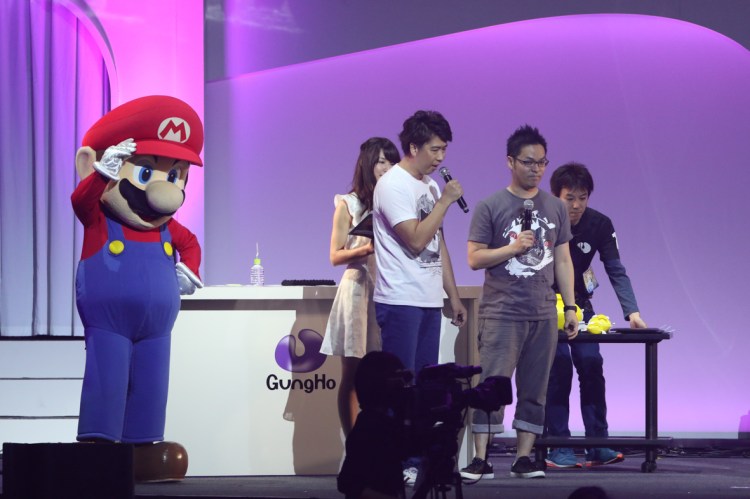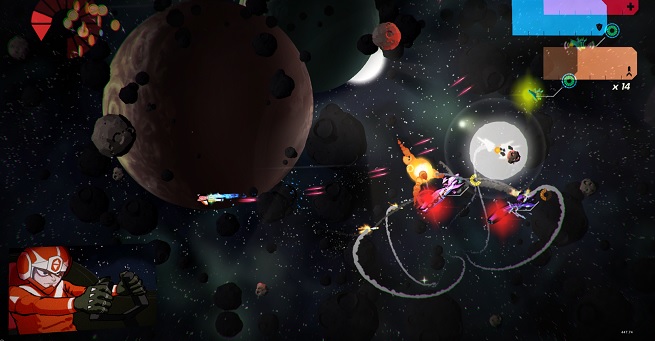GamesBeat: I’d love your thoughts and general feeling about the indie scene. I know there are some ties in your organization to indie developers. What do you think about where indies are at and where they’re going?
Morishita: For me, mentally, I’ve always thought of myself as an indie at the core, as a creator. Just a really big one, as far as the company is concerned. Obviously working with Jake and his team, these guys have a lot of passion. That’s the foremost thing they bring to the table. It’s very fresh. It’s great to work with them. When we go into a creative discussion, it’s always a good conversation. That’s something I appreciate and want to continue supporting. We’d love to partner up with indies out there who are interested. Our relationship with 17-bit is going well.
GamesBeat: As a larger organization right now, it seems like there’s a couple of ways you can go. You can foster or partner in supportive ways. Or you can profit from, but not necessarily add to, what the partner’s doing. Or you can just roll over them. It definitely sounds like you’re in that first camp. Do you have any thoughts on some of the other options?
Morishita: Going back to that core concept of is it fun or not—every company has business decisions. I don’t really have an opinion of what others do. They’re probably doing what they have to do to survive or be relevant. But based on what we do, we don’t necessarily think it’s the right thing to do or a good thing to do. It’s just more fun that way. It’s more fun to partner up with these guys and work with them, so that’s what we do.
Kazdal: The indie scene is evolving now. You had a lot of these kind of closet indies. Now more and more teams are leaving places like EA, 10 or 15 at a time. Super talented, super experienced, doing games on the scale of 15 years ago or so. Things like the old classic Lucasarts games, made by maybe 10 people with a lot of experience and fairly high-level skill sets.
You’re starting to see a bigger spectrum in the indie spaces between places like Double Fine and 17-bit, all the way down to these smaller companies. You look at the Sony booth and there are these big, mega-budget titles, but then filling in the gaps are higher-end nice-looking indie titles. They’re getting signed to fill out that necessary part of the roster. There just aren’t enough of those big titles these days. So we have everything from these two-man micro-teams to 15-man large indies – which are still totally indie. It’s great time. We’re seeing way more originality.
For a time there you’d have years where it was all one thing, all first-person shooters or whatever. Every E3 had its theme. It’s starting to diversify in a way like the early PSX days. We’re seeing some weird new titles again. It’s crucial for the health of the industry to get off the big gravy trains and do more different-sized stuff.
GamesBeat: I love that line of thinking, getting away from serialized, yearly repeats.
Kazdal: But you need to spend less money when you make it so you can make less money when you sell it so you can take more risks.
GamesBeat: What do you say to those who feel – money people, for the most part — that there’s an all-mobile, all-casual future to the game industry?
Morishita: Hmmm. Obviously mobile is considered more casual while console is more hardcore. I get that there’s a separation there. But there are titles that cross over and do well. If a mobile game is more fun as a mobile game and doesn’t cross over, it should stay that way, though.
Whether our market is going in a more casual direction or not, fundamentally, if it’s fun, people will play it, casual or hardcore. We’re not necessarily thinking about a shift to casual or a shift to mobile or a shift to whatever. The games that sell are usually the ones that are fun. If you take a step further beyond casual gamers, there are people who just don’t play any games. Being able to reach out to the casual crowd, what you’re actually doing is reaching out to people who’ve never played games and getting them to play games.
That’s the first step. They start playing games and become a casual gamer. From there on out, our goal at Gung Ho–For example, with Puzzle & Dragons, we probably got a lot of players who never played an RPG before. Because of the gameplay, they’re able to go in and try the game and still enjoy it. Once they realize that games are fun for them, once they become a fan of Puzzle & Dragons, we’re able to reach out to them again with different titles. Next time it might be something mid-core. They might convert from casual gamers to mid-core gamers.
That’s a loop we’re trying to target. It’s not as if casual games are bad. They have a great purpose and we’d like to explore those areas as well. That’s always in our mindset. Whether we create a completely casual game in the future, it’s not even decided yet.
At our Gung Ho festival we had in Japan, we had 110,000 people. The crowd there, are they actually core gamers? Probably not. They’re mostly families. We had this huge float with a ball pit. It’s family-oriented. Parents bring their kids and enjoy the day with them. That’s not really a core gamer audience. But they’ve become our core fanbase, if you see what I mean.
VentureBeat's mission is to be a digital town square for technical decision-makers to gain knowledge about transformative enterprise technology and transact. Learn More



